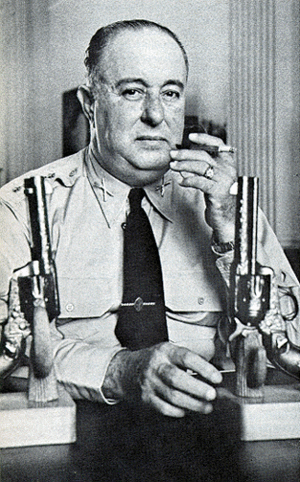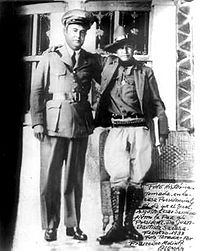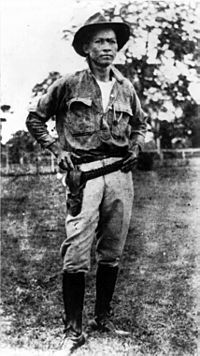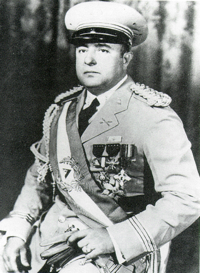Anastasio Somoza García facts for kids
Quick facts for kids
Anastasio Somoza Garcia
|
|
|---|---|

Somoza in 1952
|
|
| President of Nicaragua | |
| In office 21 May 1950 – 29 September 1956 |
|
| Vice President | Vacant |
| Preceded by | Manuel Fernando Zurita |
| Succeeded by | Luis Somoza Debayle |
| In office 1 January 1937 – 1 May 1947 |
|
| Vice President | Francisco Navarro Alvarado |
| Preceded by | Carlos Alberto Brenes |
| Succeeded by | Leonardo Argüello Barreto |
| Personal details | |
| Born | 1 February 1896 San Marcos, Carazo, Nicaragua |
| Died | 29 September 1956 (aged 60) Ancón, Panama Canal Zone, Panama |
| Political party | Nationalist Liberal Party |
| Spouse |
Salvadora Debayle
(m. 1919) |
| Children | Lillian Somoza Debayle Luis Somoza Debayle Anastasio Somoza Debayle |
| Profession | Politician, Army General |
| Military service | |
| Allegiance | |
| Branch/service | National Guard |
| Years of service | ?-1956 |
| Rank | Brigadier General |
Anastasio Somoza García (born February 1, 1896 – died September 29, 1956) was a powerful leader in Nicaragua. He ruled the country from 1937 until he was killed in 1956. Even though he was officially the 21st President of Nicaragua for two terms (1937-1947 and 1950-1956), he held power for the rest of the time as a strong military leader.
Somoza García was the first leader of the Somoza family. This family controlled Nicaragua like a family kingdom for 42 years.
Somoza came from a rich family that grew coffee. He studied in the United States. When he came back to Nicaragua, he helped remove President Adolfo Díaz from power. He then became the foreign secretary and was called "General."
With help from the United States Marine Corps, who were in Nicaragua at the time, Somoza became the head of the National Guard. This gave him a lot of power. He used this power to make his wife's uncle, Juan Bautista Sacasa, step down as president. Somoza then became president himself in 1937.
Even when someone else was officially president, Somoza still held the real power. In 1947, an ally took over as president, but Somoza remained in control behind the scenes. A month after this new president started, Somoza used the military to take over again. He returned as president in 1950.
Somoza had strong control over his own political party and made a deal with the opposing party. This meant he faced no real challenge to his rule. This allowed him to gather a huge amount of personal wealth.
On September 21, 1956, a poet named Rigoberto López Pérez shot Somoza. He was badly hurt and flown to the Panama Canal Zone. He died there a week later. His oldest son, Luis Somoza Debayle, took over as acting president. He was later elected president in 1957. Luis ruled until 1963 and continued to be powerful behind other presidents until he died in 1967.
His younger brother, Anastasio Somoza Debayle, also became president. He ruled until 1972 and again from 1974. He was forced to leave Nicaragua in 1979 and was killed in Paraguay the next year.
Contents
Biography
Anastasio Somoza García was born in San Marcos, Carazo, Nicaragua. His father, Anastasio Somoza Reyes, was a wealthy coffee farmer. His mother was Julia García.
As a teenager, Somoza went to live with relatives in Philadelphia, United States. He studied at the Peirce School of Business Administration there. While in Philadelphia, he met his future wife, Salvadora Debayle Sacasa. She came from one of Nicaragua's richest families. After returning to Nicaragua, Somoza tried to be a businessman but was not very successful at first.
Marriage and Family Life
Somoza married Salvadora Debayle in 1919. They had two sons, Luis Somoza Debayle and Anastasio Somoza Debayle. They also had a daughter named Lillian Somoza de Sevilla Sacasa.
Early Steps in Politics
In 1926, Somoza joined a rebellion by the Liberal party. This rebellion supported his wife's uncle, Juan Bautista Sacasa, for president. Somoza did not do well in battles. For example, his attack on a military base in San Marcos failed.
However, because he had studied in the United States, he spoke excellent English. This skill was very useful. He became an interpreter during peace talks between the fighting groups. These talks were arranged by the United States.
In the government of President José María Moncada, Somoza held several important jobs. He was the governor of the León Department, a Nicaraguan Consul in Costa Rica, and the Foreign Minister. Even though he had little military experience, Somoza moved up quickly in the National Guard. This was a police and military force set up by the United States Marine Corps.
Somoza and Sandino
The United States Marines left Nicaragua in January 1933. This happened after a six-year fight with the forces of General Augusto César Sandino. Juan Bautista Sacasa was elected president. The U.S. Ambassador Matthew E. Hanna encouraged Somoza García to become the director of the National Guard.
During peace talks, Somoza ordered the killing of General Sandino on February 21, 1934. This was against a promise of safety that had been made. After Sandino's death, the National Guard also killed many of his former supporters.
Ruling Nicaragua
How Somoza Controlled the Government
In 1936, Somoza used the National Guard to take power. He forced President Sacasa to resign in June. Carlos Alberto Brenes then ruled for a short time. In December, Somoza was elected president. The election results showed he won by a huge number of votes. This was likely due to widespread cheating. He became president on January 1, 1937.
People often called Somoza "Tacho." He changed the country's laws to put all power in his own hands. His family members and close friends got all the important jobs in the government and military.
Nicaragua During World War II
During World War II, Somoza's government took properties from German people living in Nicaragua. These properties were then sold to Somoza and his family for very low prices. By 1944, Somoza owned the most land in Nicaragua. He had many cattle ranches and coffee farms. He also owned sugar mills and rum factories.
Somoza made himself the director of the Pacific Railroad. This railroad connected the capital city, Managua, to the main port, Corinto. This meant his goods and crops were moved for free. The railroad also took care of his vehicles and farm equipment.
He also made a lot of money by letting foreign companies, mostly from the U.S., use Nicaragua's gold, rubber, and timber. He got special payments for these deals. He also made laws that limited imports and ran his own illegal trade operations. He sold goods through his own stores.
A Short Period of Hope
In 1944, the United States put pressure on Somoza to make his rule more democratic. He agreed to let unions be legal. He also promised not to run for president again in 1947. His party chose an older doctor named Leonardo Argüello to run. Somoza used the National Guard to make sure Argüello won the election.
Somoza planned for Argüello to be a "puppet" president. This meant Argüello would do whatever Somoza wanted. Somoza wanted to keep the real power until he could run for president again in 1952. However, when Argüello became president in May 1947, he started to act independently. He tried to reduce the power of the National Guard and Somoza's control over the economy.
Less than a month later, Somoza organized another takeover. He named one of his wife's uncles, Benjamín Lacayo Sacasa, as president. This event ended any hope for Nicaragua to become more democratic under Somoza's rule.
Second Time as President
The U.S. President Harry S. Truman did not recognize the new government at first. So, a special assembly was called. This assembly appointed Somoza's uncle, Víctor Manuel Román y Reyes, as president.
In another election that was clearly unfair, Somoza García became president again in 1950. In the 1950s, he made his business empire even bigger and better organized. He started a shipping company, several textile factories, and a national airline called LANICA. He also built a new port on the Pacific coast near Managua, which he named Puerto Somoza. (Later, after a revolution, it was renamed Puerto Sandino.) He also bought properties in the United States and Canada.
Assassination and What Happened Next
In 1955, the laws were changed to let Somoza run for another term as president. Soon after he was nominated, a poet named Rigoberto López Pérez shot him. This happened on September 21, 1956, in the city of León. Somoza died several days later in a hospital in the Panama Canal Zone.
Somoza's sons, Luis and Anastasio Somoza Debayle, then ruled Nicaragua. They either ruled directly or through other politicians for the next 23 years. Even though there was a lot of corruption and people were stopped from speaking out, the United States supported them. The U.S. saw them as strong against communism and a source of stability.
Somoza's daughter, Lillian Somoza Debayle, was born in León, Nicaragua, on May 3, 1921. She married Guillermo Sevilla Sacasa, who was Nicaragua's Ambassador to the United States during her brothers' rule. Somoza also had another son named José R. Somoza, whose mother is not known.
Anastasio Somoza García is buried with his oldest son at Cementerio Occidental in Managua, Nicaragua. They are in the National Guard Mausoleum. (He should not be confused with his son, Anastasio Somoza Debayle, who is buried in Miami.)
Images for kids
-
Somoza (left), with Argentine President Juan Perón, in 1953.
See Also
 In Spanish: Anastasio Somoza García para niños
In Spanish: Anastasio Somoza García para niños
- National Guard (Nicaragua)
- Nicaraguan Revolution





